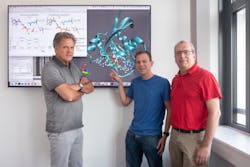Researchers at Ruhr University Bochum (Bochum, Germany) and collaborators from Uppsala University (Uppsala, Sweden) have identified a new mechanism for the deactivation of switch proteins. Such proteins, including Ras, regulate many processes in the body and affect diseases such as cancer.
Bound to switch proteins, the GTP molecule is vital for the deactivation of many of them. If one of the three phosphate groups is detached from GTP, the protein switches to "off," thus affecting cellular processes. "The proteins are extremely efficient and accelerate reactions that would usually take billions of years so that they are executed within the fraction of a second," says Klaus Gerwert, a professor in the Department of Biophysics at Ruhr University Bochum, who led the work along with Till Rudack, project group leader.
Related: Spectroscopy method helps decode protein used in optogenetics
At least one water molecule is always involved in the deactivation process. To date, researchers assumed that this water molecule had to be activated, namely by a reaction partner transferring a proton to the water molecule. "The nature of the reaction partner has been argued for decades—is it the GTP itself or is it a protein component?" explains Carsten Kötting, one of the authors from the Ruhr University Bochum-based team. "In the current study, we have surprisingly identified an entirely new mechanism, where the activation takes place without any proton transfer whatsoever."
Using computer-aided analysis, the team studied all deactivation options for seven different switch protein systems. The researchers thus identified various speeds for the deactivation process. They compared the calculated speeds with values gained in experiments through time-resolved spectroscopy (specifically, time-resolved infrared spectroscopy).
While the values for the two previously suspected mechanisms deviated strongly from each other, the experimental results for the newly identified mechanism corresponded with theoretical assumptions—for all seven tested systems, at that. "The matches show that our newly discovered deactivation mechanism is universal and, consequently, is relevant for numerous cellular processes," concludes Rudack.
"Diseases are often caused by a defect in the deactivation mechanism of key proteins," says Rudack. "In order to understand the molecular processes underlying diseases and to develop therapies, we have to understand the deactivation mechanism first."
The newly identified deactivation mechanism is, for example, responsible for switching Ras off, a protein whose defects result in uncontrolled cellular growth in tumors. Researchers have been trying for decades to find a drug that affects the dysfunctional Ras protein in human tumors. "We expect that our results explain why the search has remained fruitless to date," says Gerwert. "The correct molecular deactivation mechanism can now become the starting point for the development of anti-cancer drugs."
Full details of the work appear in the Journal of the American Chemical Society.
